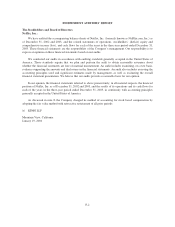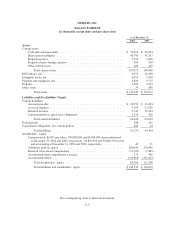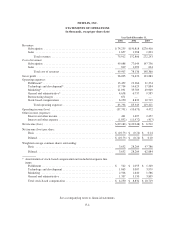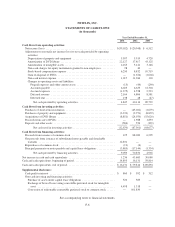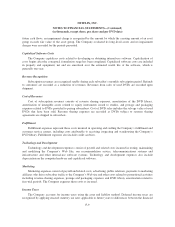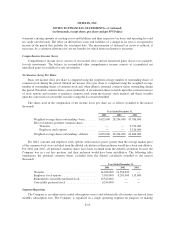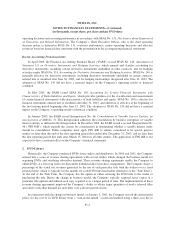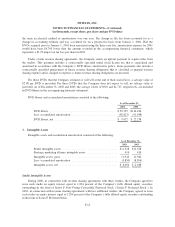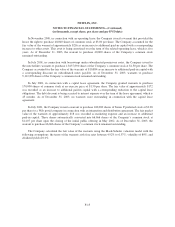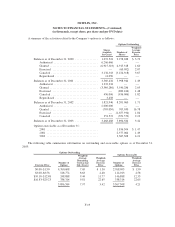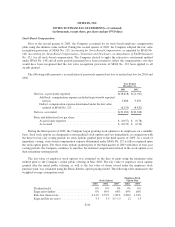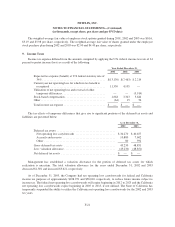NetFlix 2003 Annual Report Download - page 69
Download and view the complete annual report
Please find page 69 of the 2003 NetFlix annual report below. You can navigate through the pages in the report by either clicking on the pages listed below, or by using the keyword search tool below to find specific information within the annual report.NETFLIX, INC.
NOTES TO FINANCIAL STATEMENTS—(Continued)
(in thousands, except share, per share and per DVD data)
operating decisions and assessing performance in accordance with SFAS No. 131, Disclosures about Segments of
an Enterprise and Related Information. The Company’s Chief Executive Officer, who is the chief operating
decision maker as defined in SFAS No. 131, evaluates performance, makes operating decisions and allocates
resources based on financial data consistent with the presentation in the accompanying financial statements.
Recent Accounting Pronouncements
In April 2003, the Financial Accounting Standard Board (“FASB”) issued SFAS No. 149, Amendment of
Statement 133 on Derivative Instruments and Hedging Activities, which amends and clarifies accounting for
derivative instruments, including certain derivative instruments embedded in other contracts, and for hedging
activities under SFAS No. 133, Accounting for Derivative Instruments and Hedging Activities. SFAS No. 149 is
generally effective for derivative instruments, including derivative instruments embedded in certain contracts,
entered into or modified after June 30, 2003, and for hedging relationships designated after June 30, 2003. The
adoption of SFAS No. 149 did not have a material impact on the Company’s operating results or financial
condition.
In May 2003, the FASB issued SFAS No. 150, Accounting for Certain Financial Instruments with
Characteristics of Both Liabilities and Equity, which provides guidance for the classification and measurement
of certain financial instruments with characteristics of both liabilities and equity. SFAS No. 150 is effective for
financial instruments entered into or modified after May 31, 2003, and otherwise is effective at the beginning of
the first interim period beginning after June 15, 2003. The adoption of SFAS No. 150 did not have a material
impact on the Company’s operating results or financial condition.
In January 2003, the FASB issued Interpretation No. 46, Consolidation of Variable Interest Entities, an
interpretation of ARB No. 51. This Interpretation addresses the consolidation by business enterprises of variable
interest entities as defined in the Interpretation. In December 2003, the FASB issued a revised Interpretation No.
46 (“FIN 46R”), which expands the criteria for consideration in determining whether a variable interest entity
should be consolidated. Public companies must apply FIN 46R to entities considered to be special purpose
entities no later than the end of the first reporting period that ended after December 15, 2003, and no later than
the first reporting period that ends after March 15, 2004 for all other entities. The application of FIN 46R is not
expected to have a material effect on the Company’s financial statements.
2. DVD Library
Historically, the Company purchased DVDs from studios and distributors. In 2000 and 2001, the Company
entered into a series of revenue sharing agreements with several studios which changed the business model for
acquiring DVDs and satisfying subscriber demand. These revenue sharing agreements enable the Company to
obtain DVDs at a lower up front cost than under traditional direct purchase arrangements. The Company shares a
percentage of the actual net revenues generated by the use of each particular title with the studios over a fixed
period of time, which is typically twelve months for each DVD title (hereinafter referred to as the “Title Term”).
At the end of the Title Term, the Company has the option of either returning the DVD title to the studio or
purchasing the title. Before the change in business model, the Company typically acquired fewer copies of a
particular title upfront and utilized each copy acquired over a longer period of time. The implementation of these
revenue sharing agreements improved the Company’s ability to obtain larger quantities of newly released titles
and satisfy subscriber demand for such titles over a shorter period of time.
In connection with the change in business model, on January 1, 2001, the Company revised the amortization
policy for the cost of its DVD library from a “sum-of-the-month” accelerated method using a three-year life to
F-11



